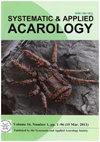葡萄牙北部葡萄园中的捕食性Phytoseidae螨(Acari:中斯的目)
IF 1.2
3区 农林科学
Q2 ENTOMOLOGY
引用次数: 0
摘要
摘要类植物素是重要的生物防治剂。这项工作旨在了解植物类螨的多样性,并比较在葡萄牙北部葡萄产区发现的这些螨的丰度和丰富度。2017年7月至9月,在Ave、Cávado、Douro、Lima和Minho Rivers分区域的25个葡萄园(Ave 3个,Cávado 4个,Douro 8个,Lima 5个,Minho Rivers 5个)进行了采样,每个葡萄园收集50片叶子。共发现植物螨4372只,其中利马最高,平均每叶6.4只,杜罗和米尼奥次之,平均2.5只,Ave平均2.0只。Ave和Douro的丰富度最高,占物种总数的80%。除Ave河与Douro河、Cávado河与Douro河、Cávado河与Minho河外,几乎所有河流均以pyri斑疹伤寒病为主;在这些病例中,杜罗和米尼奥以异常kampimodromans为主。这种情况也发生在杜罗河和米尼奥罗河的畸变K.和兴奋斑疹伤寒的比较中。与Ave和Minho相比,Minho以T.振奋菌为主。了解葡萄牙北部研究地区存在的植物类植物有助于制定生物防治策略并平衡这些农业生态系统。本文章由计算机程序翻译,如有差异,请以英文原文为准。
Predatory Phytoseiidae mites (Acari: Mesostigmata) in vineyards of northern Portugal
Abstract Phytoseiids are important biological control agents on different cultivated plants. This work aimed to know the diversity of phytoseiids and compare the abundance and richness of these mites found in grape-producing regions located in northern Portugal. Samplings were conducted in the subregions of Ave, Cávado, Douro, Lima and Minho Rivers between July and September 2017, in 25 vineyards (three in Ave, four in Cávado, eight in Douro, five in Lima and five in Minho Rivers), by collecting 50 leaves/vineyard. A total of 4,372 phytoseiid mites were found, and the highest abundance of phytoseiids per leaf was in Lima, with an average of 6.4, followed by Douro and Minho, with 2.5 and Ave, with 2.0. The highest richness was found in Ave and Douro, with 80% of the species reported. Typhlodromus pyri predominated in nearly all rivers, except when comparing Ave versus Douro, Cávado versus Douro and, Cávado versus Minho; in these cases, Kampimodromus aberrans predominated in Douro and Minho. This also occurred when K. aberrans and Typhlodromus exhilaratus were compared between Douro and Minho. Comparing Ave and Minho, T. exhilaratus predominated in Minho. Knowing about the phytoseiids present in the studied regions of northern Portugal helps develop biological control strategies and balance these agroecosystems.
求助全文
通过发布文献求助,成功后即可免费获取论文全文。
去求助
来源期刊

Systematic and Applied Acarology
ENTOMOLOGY-
CiteScore
2.20
自引率
33.30%
发文量
152
期刊介绍:
Systematic and Applied Acarology (SAA) is an international journal of the Systematic and Applied Acarology Society (SAAS). The journal is intended as a publication outlet for all acarologists in the world.
There is no page charge for publishing in SAA. If the authors have funds to publish, they can pay US$20 per page to enable their papers published for open access.
SAA publishes papers reporting results of original research on any aspects of mites and ticks. Due to the recent increase in submissions, SAA editors will be more selective in manuscript evaluation: (1) encouraging more high quality non-taxonomic papers to address the balance between taxonomic and non-taxonomic papers, and (2) discouraging single species description (see new special issues for single new species description) while giving priority to high quality systematic papers on comparative treatments and revisions of multiple taxa. In addition to review papers and research articles (over 4 printed pages), we welcome short correspondence (up to 4 printed pages) for condensed version of short papers, comments on other papers, data papers (with one table or figure) and short reviews or opinion pieces. The correspondence format will save space by omitting the abstract, key words, and major headings such as Introduction.
 求助内容:
求助内容: 应助结果提醒方式:
应助结果提醒方式:


